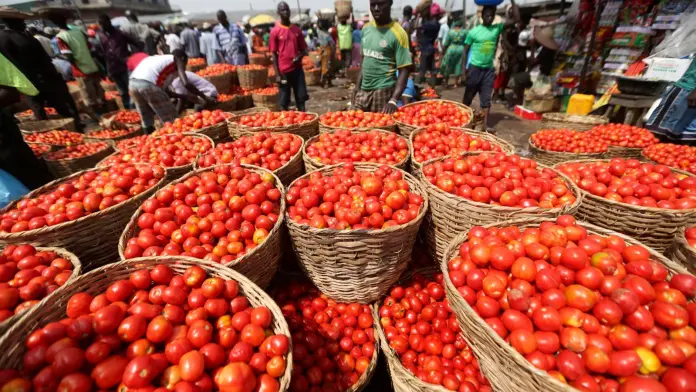By Anthony Kofituo MORRISON
Tomatoes are an indispensable part of Ghanaian cuisine, featuring prominently in a myriad of daily dishes. However, the escalating cost of tomatoes has become a heavy burden for many consumers, straining household budgets and threatening food security. Prices can surge dramatically, often doubling or tripling during off-peak seasons. These price hikes are driven by several factors, including the seasonal nature of production, substantial post-harvest losses, and a heavy reliance on costly imports.
The financial strain from high tomato prices has extensive implications. Low-income families, in particular, may reduce their tomato consumption, leading to potential nutritional deficiencies. Street food vendors and small restaurant owners, faced with increased costs, often pass these expenses on to consumers, further exacerbating food insecurity. The root causes of these high prices lie in deeper systemic issues within Ghana’s agricultural sector, such as inadequate infrastructure, limited access to quality inputs, and inconsistent government policies.
The Tomato Industry: A microcosm of agricultural woes
Despite favorable climatic conditions for growing tomatoes, Ghana relies heavily on imports to meet domestic demand. This dependency highlights critical weaknesses in local agricultural practices, infrastructure, and policy support. Seasonal production variability, high post-harvest losses, and insufficient investment in cold storage and transportation infrastructure further exacerbate the problem, forcing reliance on imports from countries like Burkina Faso and Morocco.
Agriculture is the backbone of Ghana’s economy, providing employment for over half of the population and contributing significantly to the country’s GDP. Yet, despite its vital role, the sector struggles with numerous challenges that hinder its full potential. The plight of the tomato industry in Ghana exemplifies the broader issues plaguing the agricultural sector. This article delves into the harsh realities faced by tomato farmers, the systemic problems caused or ignored by the government, and explores actionable steps to transform Ghana into a self-sufficient and net exporter of tomatoes.
Government neglect and policy failures
Inconsistent Agricultural Policies
-
Lack of Long-Term Planning: The government has often implemented agricultural policies that lack long-term vision and consistency. Initiatives like the Planting for Food and Jobs (PFJ) program, while well-intentioned, have suffered from poor implementation and inadequate follow-through.
-
Regulatory Challenges: The regulatory environment is often cumbersome and inconsistent, deterring investment and innovation in the agricultural sector.
Infrastructure Deficits
Neglected Rural Infrastructure: The government has not prioritized the development of essential infrastructure in rural areas. Poor road networks and lack of reliable transportation systems hinder the efficient movement of tomatoes from farms to markets, leading to high post-harvest losses.
Inadequate Storage Facilities – Cold Chain: Despite the known perishability of tomatoes, there has been little investment in cold storage facilities. This neglect results in significant post-harvest losses and forces farmers to sell their produce quickly at lower prices.
Limited Support for Research and Development
Underfunded Agricultural Research: The government has not sufficiently funded research institutions to develop high-yield, disease-resistant, and drought-tolerant tomato varieties. Without these advancements, farmers continue to struggle with low productivity and high vulnerability to pests and diseases.
Lack of Extension Services: Extension services are crucial for educating farmers on best practices. However, these services are often under-resourced and poorly managed, leaving farmers without the necessary support to improve their yields and profitability.
Access to Inputs and Financing
High Cost of Inputs: Farmers face high costs for quality seeds, fertilizers, and pesticides, with minimal subsidies or financial support from the government. This lack of assistance limits their ability to adopt modern farming techniques.
Scarce Credit Facilities: The government has not facilitated adequate access to affordable credit for smallholder farmers. Without financial support, farmers cannot invest in necessary inputs and infrastructure.
Seasonal Production and Perishability
Tomato farming in Ghana is highly seasonal. Peak harvests occur from January to March, while the rainy season, spanning from April to September, sees a sharp decline in production. This seasonal variability creates significant supply gaps that are filled by imports, particularly from Burkina Faso and Morocco. The perishability of tomatoes exacerbates the problem. With inadequate storage and cold chain infrastructure, a significant portion of the local harvest is lost post-harvest. Farmers are forced to sell their produce quickly at lower prices to avoid spoilage, resulting in minimal profits and substantial food waste.
Quality Mismatch
The types of tomatoes produced locally are often not suited for the needs of the market, especially the processing industry. Local varieties, such as the popular Roma tomato, have high water content and short shelf life, making them less suitable for processing into paste, sauces, and canned products. In contrast, imported varieties are preferred for their firmer texture, lower water content, and consistent quality, which are ideal for industrial use.
The Economic Impact of Tomato Imports
Ghana spends a substantial amount of foreign exchange on importing tomatoes. The country spends approximately US$400 million annually to import fresh tomatoes, primarily from Burkina Faso. This significant outflow of foreign exchange highlights the economic cost of the country’s dependency on imports and underscores the urgent need to bolster local production (National Food Buffer Stock Company) (AgricToday).
Pathways to Self-Sufficiency and Export Potential
Varietal Improvement and Adoption
Demand for Processing Varieties: The market demands tomatoes with lower water content and firmer texture, suitable for processing into paste and sauces. Hybrid varieties that meet these criteria, such as those developed in research institutions, should be promoted.
Partnership with research institutions in European, South American, and Asian countries that have adopted “seed without borders” to provide tomato lines that have undergone initial breeding trials for Ghana to evaluate within 2-3 years to get the right varieties that suit our climatic conditions so we avoid the long term (8-9 years breeding) work.
Research and Development: Investing in research to develop high-yield, disease-resistant, and drought-tolerant tomato varieties is crucial. Collaborations with agricultural universities and international research bodies can expedite this process.
The Ghana Food Research Fund.
The fund’s establishment will drive Research into smart technologies such as IoT and satellite imaging to detect pests and diseases. R & D in horizontal and vertical ecosystems must be implemented in greenhouse technologies.
Infrastructure Development
Cold Storage Facilities: Establishing cold storage facilities at key production sites and markets can significantly reduce post-harvest losses and extend the shelf life of tomatoes and processing equipment.
Improved Transportation: Upgrading road networks and transportation systems will facilitate the efficient movement of tomatoes from farms to markets, reducing spoilage and cost.
Access to Inputs and Financing
Subsidies and Incentives: Providing subsidies for high-quality seeds, fertilizers, and pesticides can improve productivity. Incentives for adopting modern farming techniques, such as drip irrigation and greenhouse farming, can also boost yields. For example, in Japan, the government gives 50% subsidies to farmers. Ghana should learn from Japan.
Microfinance and Credit Facilities: Expanding access to affordable credit through microfinance institutions and agricultural banks can empower farmers to invest in necessary inputs and infrastructure.
Extension Services and Training
Farmer Education: Strengthening agricultural extension services to educate farmers on best practices for tomato cultivation, pest management, and post-harvest handling is essential.
Adoption of the use of infographics, and mobile apps in different languages for building the capacity of farmers’ agricultural best practices should be mandatory.
Capacity Building: Training programs focusing on modern agricultural techniques, financial literacy, and market access can enhance the capacity of farmers to operate efficiently and profitably.
Market Development and Policy Support
Domestic and Export Markets: Developing both domestic and international markets for Ghanaian tomatoes can enhance profitability. Establishing quality standards and certifications can make local tomatoes competitive in global markets.
Supportive Policies: Implementing policies that promote investment in the tomato value chain, including tax incentives for agro-processors and exporters, can drive industry growth. Ensuring consistent and supportive agricultural policies will create a stable environment for farmers and investors.
Pest and Disease Management
Integrated Pest Management (IPM): Promoting IPM practices can help manage pests and diseases sustainably. Research into biological control methods and resistant varieties should be prioritized. The application of satellite services in pest and disease detection is key.
Extension Support: Providing timely and effective support to farmers through extension services can help mitigate the impact of pests and diseases on tomato crops. AI prompts must be adopted and privatization of extension must be affected.
Conclusion
The sad reality of the agricultural sector in Ghana, exemplified by the tomato industry, underscores the need for comprehensive and strategic interventions. Ghana can transform its tomato industry by addressing the challenges of varietal suitability, infrastructure deficits, access to inputs and financing, and market development. The government’s neglect and policy failures have exacerbated these issues, but with concerted efforts from the government, private sector, and international partners, Ghana has the potential to become self-sufficient in tomato production and emerge as a net exporter, contributing significantly to food security and economic growth.
In summary
-
Post-harvest losses: Many tomatoes rot before reaching the market due to inadequate storage and transportation facilities.
-
Lack of irrigation: Tomato farming relies heavily on rainfall, which can be unpredictable. Irrigation systems are scarce, making it difficult for farmers to maintain consistent yields.
-
Pests and diseases: Tomato crops are susceptible to various pests and diseases, such as the tomato leaf miner and bacterial wilt, which can significantly reduce yields.
-
Limited access to markets: Smallholder farmers often struggle to connect with buyers, leading to low prices and income instability.
-
Outdated farming practices: Many farmers still use traditional methods, which can lead to low productivity and decreased quality.
-
Climate change: Rising temperatures and changing rainfall patterns affect tomato yields and quality.
-
Competition from imports: Cheap tomato imports from other countries can flood the market, making it difficult for local farmers to compete.
-
Greenhouse technologies, smart farming techniques utilizing IoT, Satellite and robotics, and nutrient solution technology will make tomato production sexy and attractive.










